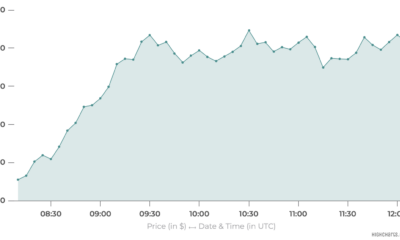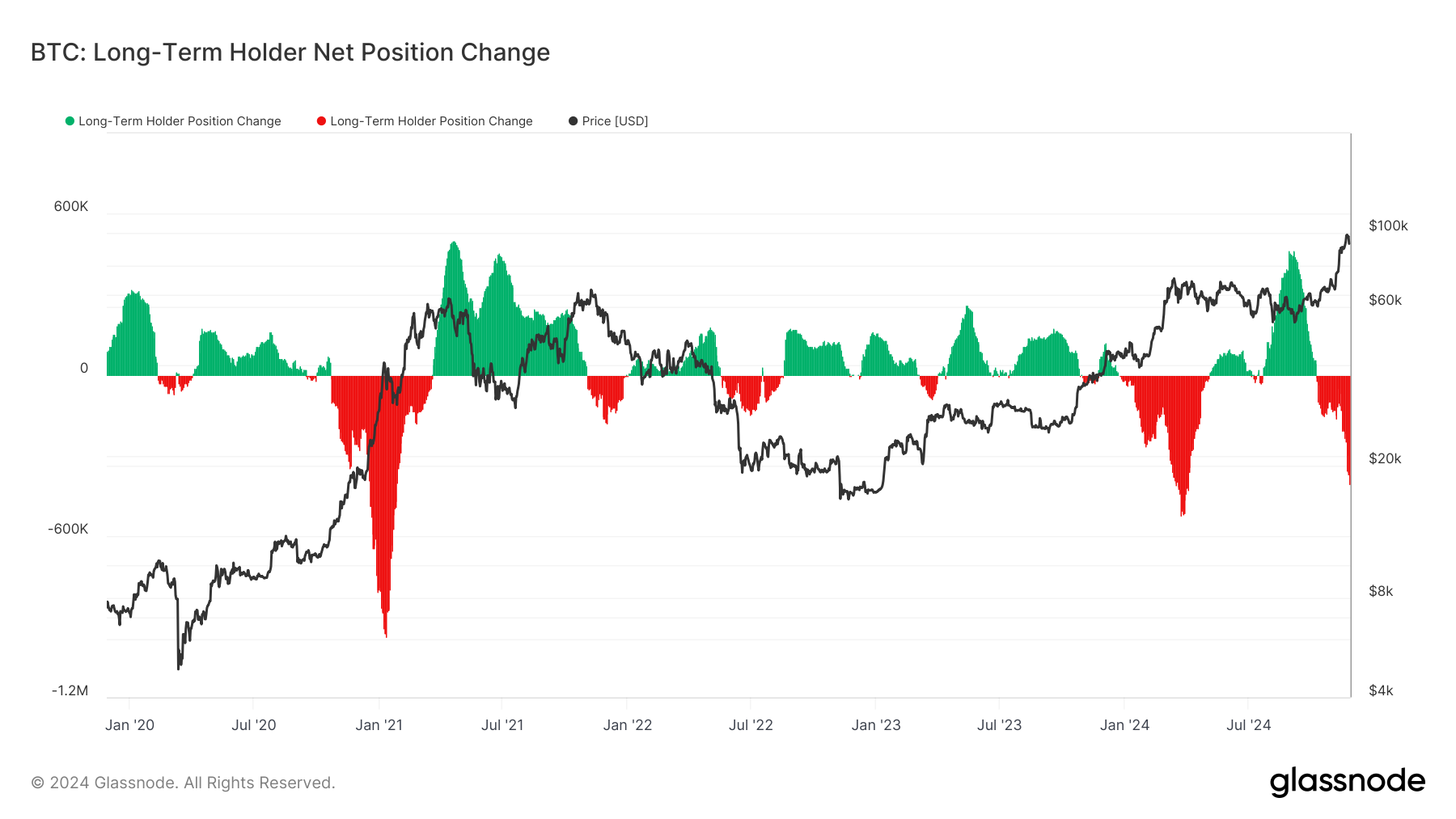Markets
Bitcoin Price Will Be ‘Range Bound’ While US Election Is Too Close to Call: Bernstein
Published
2 months agoon
By
admin

The Bitcoin price trajectory is set to be heavily influenced by the upcoming U.S. presidential election, Bernstein on Tuesday said, suggesting that if former President Donald Trump wins the 2024 election, Bitcoin could soar to unprecedented levels, exceeding $80,000 to $90,000.
However, in the event of a Kamala Harris victory, the near-term outlook for Bitcoin could see a sharp decline, potentially testing a new low in the $40,000 range.
“We expect Bitcoin to continue reacting to election odds, and turn more positive, if it starts sensing better Trump odds, and become range bound, if the race continues as ‘too close to call,'” said Gautam Chhugani, Global Head of Digital Assets at Bernstein, in a note shared with Decrypt.
He added that while Trump has been more overt in his courting of crypto voters, “Harris has been more conservative in her stance on digital assets, which could result in less regulatory support for the industry in the near term.”
Bernstein’s analysis also factors in market sentiment, with the report mentioning that traders on decentralized betting platform Polymarket have significantly increased positions on a Trump victory. “While not a certainty, the odds have shifted meaningfully in Trump’s favor, which suggests traders are preparing for a Trump win and its impact on markets, especially in the crypto sector,” the report said.
As of now, Polymarket shows a 7% lead for Trump over Harris. Polymarket’s odds are often seen as a reflection of market sentiment, and recent shifts in favor of Trump may impact Bitcoin’s potential price movement in the near term.
It’s been mentioned before that Polymarket explicitly excludes U.S. users from its platform and that its blockchain roots might mean its users have an inherent bias for Trump, who’s made many more explicit campaign promises to the crypto industry than his opponent. But Bernstein disagrees for the simple reason that there’s too much money on the line.
“We believe, the Polymarket liquidity with more than $1.5 billion of bets is real money in play and bettors would bet on probability than actually reflecting their bias,” the analysts write.
They further highlighted that while both candidates support digital assets, Trump’s administration is expected to provide broader backing, especially in areas such as Bitcoin mining and institutional adoption. According to the report, Trump’s policies could lead to Bitcoin breaking its previous all-time high of $74,000, pushing the cryptocurrency to new heights.
“We anticipate that Bitcoin could touch $80,000 to $90,000 if Trump secures the presidency,” the analysts said. “However, if Harris wins, there’s a risk of Bitcoin testing the lower end of the $40,000 range in the near term, reflecting concerns over regulatory tightening.”
The report also emphasizes that the outcome of the election will have implications not only for Bitcoin but also for other cryptocurrencies like Ethereum (ETH) and Solana (SOL). “We expect other crypto assets to remain range-bound until there is more clarity post-election, with Bitcoin leading the market’s movement,” the report states.
Edited by Stacy Elliott.
Daily Debrief Newsletter
Start every day with the top news stories right now, plus original features, a podcast, videos and more.
Source link
You may like


Will This Sell Signal Trigger ETH Crash?


No, Michael Saylor Doesn't Control Bitcoin


This Solana Rival Is Looking Great Amid Bitcoin Pullback, Says Top Crypto Analyst


Capybara is down by nearly 30% in 24-hour trading


Can Dogecoin Price Realistically Hit $4.20?


Remembering John McAfee's Bullish Bitcoin Price Bet as we near $100K Milestone
Markets
Cramer Doubles Down on Bitcoin, Pushes Back Against Criticism He Called the Top
Published
7 hours agoon
November 27, 2024By
admin

Jim Cramer, the animated host of CNBC’s “Mad Money,” has become something of an unintentional crypto market indicator—just not in the way he probably hoped.
The commentator defended his crypto stance Tuesday during another installment of his market entertainment show, citing government spending and deficit concerns.
On Friday, the firebrand stock enthusiast issued a bullish call on Bitcoin, sending Crypto Twitter into a frenzy and prompting onlookers to declare that the asset had peaked.
Two days later, Bitcoin’s price fell 5%, erasing nearly $5,000 from its value and pushing long liquidations to an 11-day high above $344 million.
“I got a bunch of yahoos saying I called the top on crypto by recommending it,” Cramer said, adding there were people who wanted to “rake me over the coals for something I did wrong 10, 15, 20 years ago.”
Cramer argued for crypto’s inclusion in investment portfolios despite acknowledging no concrete evidence supporting it as a hedge against economic instability.
“While there’s no proof crypto can protect you from anything, at least not yet, it’s a plausible story,” he said.
Cramer’s notorious track record of making spectacularly wrong calls has made him a living meme within certain crypto circles, particularly among young traders.
His commentary has become so infamously contrarian that some traders developed an “Inverse Cramer” strategy, believing doing the opposite of whatever he recommends is a path to profits.
The former hedge fund manager has had quite the rollercoaster relationship with Bitcoin and other cryptos over the years: from boasting about buying a farm with Bitcoin profits to flip-flopping between calling them worthless and saying nobody can kill Bitcoin.
“I think Bitcoin, Ethereum, and maybe even some other cryptocurrencies deserve a spot in your portfolio, too,” Cramer said during Tuesday’s show.
Despite maintaining that crypto deserves a spot for his audience’s portfolio, Cramer’s endorsement came with a notable caveat: he might “change his tune” if the deficit gets under control.
Edited by Sebastian Sinclair
Daily Debrief Newsletter
Start every day with the top news stories right now, plus original features, a podcast, videos and more.
Source link
Bitcoin adoption
Fidelity Investments Director Shares Bitcoin’s Adoption and Valuation Models
Published
23 hours agoon
November 26, 2024By
admin
Fidelity Investments’ Director of Global Macro, Jurrien Timmer, continues to provide insightful frameworks for understanding Bitcoin’s valuation and growth. In a recent update, Timmer shared his take on Bitcoin’s adoption and value trajectories, illustrated by detailed charts that reflect both historical trends and hypothetical scenarios.
Timmer’s models aim to simplify Bitcoin’s complex growth dynamics, bridging the gap between network adoption and valuation. “While the supply is known, the demand is not,” he stated, emphasizing the critical role of adoption curves and macroeconomic variables such as real rates and monetary policy.
Adoption Curves: Slowing But Consistent Growth
Despite a slowdown in Bitcoin’s network growth, as measured by the number of wallets with a non-zero balance, Timmer noted that the trend still aligns with the steep power curve shown in his updated adoption chart. While the internet adoption curve has a gentler slope, Bitcoin’s adoption trajectory remains steeper, signifying its rapid but maturing growth.

Importantly, Timmer highlighted a key limitation in the measurement of wallet growth: the understated wallet/address count due to Bitcoin ETFs, which consolidate holdings into just a few wallets. “It’s very likely that the wallet/address count is understated,” he said, pointing out that ETFs obscure the broader distribution of Bitcoin adoption.
Monetary Policy Meets Adoption Dynamics
Building on his previous models, Timmer added a new layer to his valuation framework by incorporating money supply growth alongside real interest rates. The updated charts compare two hypothetical paths for Bitcoin’s valuation: one driven by adoption curves and real rates, and another that includes monetary inflation as a factor.

“Again, these are not predictions,” Timmer clarified, “but merely attempts at visualizing the use case on the basis of adoption, real rates, and monetary inflation.” This layered approach underscores how external macroeconomic forces, like monetary policy, could influence Bitcoin’s adoption and valuation.
Why This Matters
Timmer’s updated models reinforce Bitcoin’s position as a maturing financial asset. By combining historical S-curves, Metcalfe’s Law, and macroeconomic factors, he offers a comprehensive view of Bitcoin’s unique blend of network utility and monetary features. His work highlights the importance of adoption in driving Bitcoin’s value, while also demonstrating how real-world monetary conditions could shape its future.
For Bitcoin proponents and skeptics alike, Timmer’s insights serve as a valuable framework for understanding the asset’s dual nature as both a network and a form of money. The inclusion of monetary inflation in his models further underscores Bitcoin’s potential as a hedge against fiat currency debasement.
The Road Ahead
As Bitcoin continues to evolve, Timmer’s models provide a critical lens for tracking its development. Whether it’s the flattening of the adoption curve or the interplay between monetary policy and valuation, his analysis underscores the asset’s growing complexity—and its enduring relevance in the financial world.
For investors, analysts, and enthusiasts, these insights are a reminder of Bitcoin’s transformative potential, even as its growth curve matures.
Source link
Bitcoin
Bitcoin Long-Term Holders Have 163K More BTC to Sell, History Indicates: Van Straten
Published
1 day agoon
November 26, 2024By
admin
Bitcoin (BTC) has dropped 7.6% since it almost — but not quite — touched the psychological wall of $100,000 on Nov. 22.
That’s the biggest drop since Donald Trump won the U.S. presidential election, sparking a rally that sent the largest cryptocurrency by market capitalization soaring from a level of around $66,000 through its record high.
Even so, the slide isn’t out of the ordinary. In bull markets bitcoin typically tumbles as much as 20% or even 30%, so-called corrections that tend to flush out leverage in an overheated market.
A large part of the reason the bitcoin price didn’t get to $100,000 was the amount of profit-taking that took place. A record dollar value of $10.5 billion of profit-taking took place on Nov. 21, according to Glassnode data, the biggest day of profit-taking ever witnessed in bitcoin.

At the root of the action are the long-term holders (LTH), a group Glassnode defines as having held their bitcoin for more than 155 days. These investors are considered “smart money” because they tend to buy when the BTC price is depressed and sell in times of greed or euphoria.
From September to November 2024, these investors have sold 549,119 BTC, or about 3.85% of their holdings. Their sales, which started in October and have accelerated since, even outweighed buying from the likes of MicroStrategy (MSTR) and the U.S. spot-listed exchange-traded funds (ETFs).

How long is this selling pressure going to last?
What’s noticeable from patterns in previous bull markets in 2017, 2021 and early 2024, is that the percentage drop gets smaller each cycle.
In 2017, the percentage drop was 25.3%, in 2021 it reached 13.4% and earlier this year it was 6.51%. It’s currently 3.85%. If this rate of decline were to continue, that would see another 1.19% drop or 163,031 BTC, which would take the cohort’s supply to 13.54 million BTC.
Each time, the long-term investors’ supply makes higher lows and higher highs, so this would also be in line with the trend.
Source link

Will This Sell Signal Trigger ETH Crash?

No, Michael Saylor Doesn't Control Bitcoin

This Solana Rival Is Looking Great Amid Bitcoin Pullback, Says Top Crypto Analyst

Capybara is down by nearly 30% in 24-hour trading

Can Dogecoin Price Realistically Hit $4.20?

Remembering John McAfee's Bullish Bitcoin Price Bet as we near $100K Milestone

Cramer Doubles Down on Bitcoin, Pushes Back Against Criticism He Called the Top

Tornado Cash smart contracts cleared of OFAC sanctions in latest ruling

Bitcoin Price May Crash Below $88,000 On Global M2 Money Correlation

Use Bitcoin Easily And Privately With Cake Wallet

Ripple Drops Another $25M Into Crypto PAC to Sway 2026 Congressional Races

Suriname presidential candidate eyes on Bitcoin adoption

US Court Rules Tornado Cash Smart Contracts Not Property, Lifts Ban

Maximizing Bitcoin Accumulation – Beyond the Benchmark

Bitcoin Crashes Under $93,000: What’s Behind It?
182267361726451435

Why Did Trump Change His Mind on Bitcoin?

Top Crypto News Headlines of The Week

New U.S. president must bring clarity to crypto regulation, analyst says

Ethereum, Solana touch key levels as Bitcoin spikes

Bitcoin Open-Source Development Takes The Stage In Nashville

Will XRP Price Defend $0.5 Support If SEC Decides to Appeal?

Bitcoin 20% Surge In 3 Weeks Teases Record-Breaking Potential

Ethereum Crash A Buying Opportunity? This Whale Thinks So

Shiba Inu Price Slips 4% as 3500% Burn Rate Surge Fails to Halt Correction

‘Hamster Kombat’ Airdrop Delayed as Pre-Market Trading for Telegram Game Expands

Washington financial watchdog warns of scam involving fake crypto ‘professors’

Citigroup Executive Steps Down To Explore Crypto
Mostbet Güvenilir Mi – Casino Bonus 2024

Bitcoin flashes indicator that often precedes higher prices: CryptoQuant
Trending

 2 months ago
2 months ago182267361726451435

 Donald Trump4 months ago
Donald Trump4 months agoWhy Did Trump Change His Mind on Bitcoin?

 24/7 Cryptocurrency News3 months ago
24/7 Cryptocurrency News3 months agoTop Crypto News Headlines of The Week

 News3 months ago
News3 months agoNew U.S. president must bring clarity to crypto regulation, analyst says

 Bitcoin4 months ago
Bitcoin4 months agoEthereum, Solana touch key levels as Bitcoin spikes

 Opinion4 months ago
Opinion4 months agoBitcoin Open-Source Development Takes The Stage In Nashville

 Price analysis4 months ago
Price analysis4 months agoWill XRP Price Defend $0.5 Support If SEC Decides to Appeal?

 Bitcoin4 months ago
Bitcoin4 months agoBitcoin 20% Surge In 3 Weeks Teases Record-Breaking Potential


